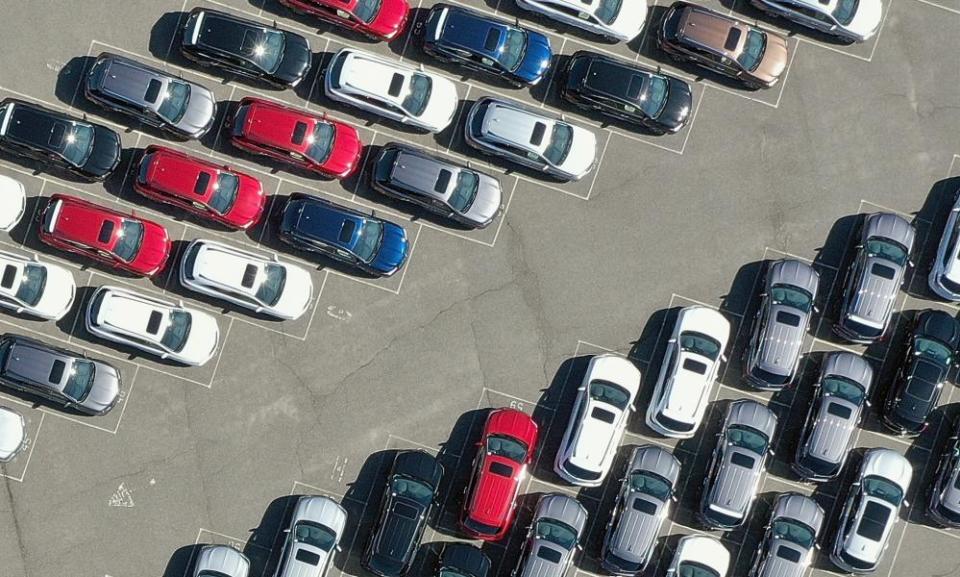Americans paying 25% more towards car loans than 10 years ago

Americans with new car loans are paying about 25% more for their vehicles every month compared with a decade ago, according to a new investigation from Consumer Reports, with auto loan debt in the US now surpassing $1.4tn.
The investigation found that thousands of borrowers were charged with high interest rates even if they had a good credit score.
Related: Know the score on mortgages: a blemish on your credit file could cost thousands
Consumer Reports used data from nearly 858,000 auto loans from 17 major lenders that were bundled into bonds and sold to investors. The data includes details such as when a loan was issued, income level, credit score, monthly payment and employment status. The data analyzed for the investigation did not specify borrowers’ racial identity. A majority of the loans were arranged through a dealership, the primary way Americans finance their cars.
Nearly 21,000 borrowers with credit scores of 660 or higher – which are considered good credit scores – had annual percentage rates (APR) ranging from 10% to 25%. About 3% of all prime and super prime borrowers were in this range, according to the data CR reviewed. Recently, the average APR for borrowers of new cars with excellent credit scores has been at 2.5% to 3.5%.
The difference in APR rates could mean thousands of dollars for consumers. The investigation noted the experiences of two people in California who received around $18,000 as loan for a 2017 Chevrolet Trax. Both had good credit scores and similar income levels, yet one had a 4.9% APR, amounting to $20,448 as payment, while the other had a 14.1% APR, equalling a payment of up to $27,540.
“Sadly, this is all too common,” Ian Ayres, a lawyer and economist at Yale Law School, told Consumer Reports. “I’ve seen a surprising number of consumers with excellent credit who are written into subprime loans.”
The data does not show any main factor that would lead to the disparity in interest rates, the investigation says, though experts suggest that dealerships and lenders sometimes give out loans with interest rates they believe they can get away with. There is limited governmental oversight on auto loans. In many states, laws regarding how high interest rates can be set are unclear, and some have no limits at all.
In most places in the US, the most convenient way to commute is by car, and so, people are willing to use larger chunks of their income to finance their vehicle. Nearly 25% of loans analyzed in the investigation took up more than 10% of a borrower’s monthly income, despite experts recommendations against doing so. Nearly 50% of those with poor credit scores further exceeded that amount.
In the loans analyzed by Consumer Reports, lenders verified the incomes of their borrowers just 4% of the time, leaving consumers at risk of receiving larger loans than they can pay.
Lana Ash, a resident of Oklahoma, alleges that the dealership she arranged her loan through falsely reported she made $5,500 a month on her loan application, ultimately leading to a higher monthly loan than she originally agreed to. When she was unable to pay the loan, the lender repossessed her car.
“I think they should take steps to make sure the person can afford the payments,” Ash, who filed a lawsuit against the lender and the dealership, told Consumer Reports. The case is pending.
Industry groups and regulators are bracing for a potential uptick in loan defaults over the coming months as pandemic-related assistance and loan-payment pauses come to an end. A CR analysis of data from the the Federal Reserve Banks of New York and Philadelphia found that while many pay their car loans without a problem, one in 12 people with a loan were more than 90 days late in their payment by spring of 2021.
In response to the analysis, industry groups and lenders told Consumer Report instances of high-credit borrowers being charged high credit rates are anomalies.
“Consumers understand that rates will vary from creditor to creditor,” Ed McFadden, a spokesperson for the American Financial Services Association, told Consumer Reports. “They have ample opportunity to research and shop.”
The data analyzed by Consumer Reports was from data disclosed to the US Securities and Exchange Commission in 2019 and 2020 and is not nationally representative.

 Yahoo Finance
Yahoo Finance 